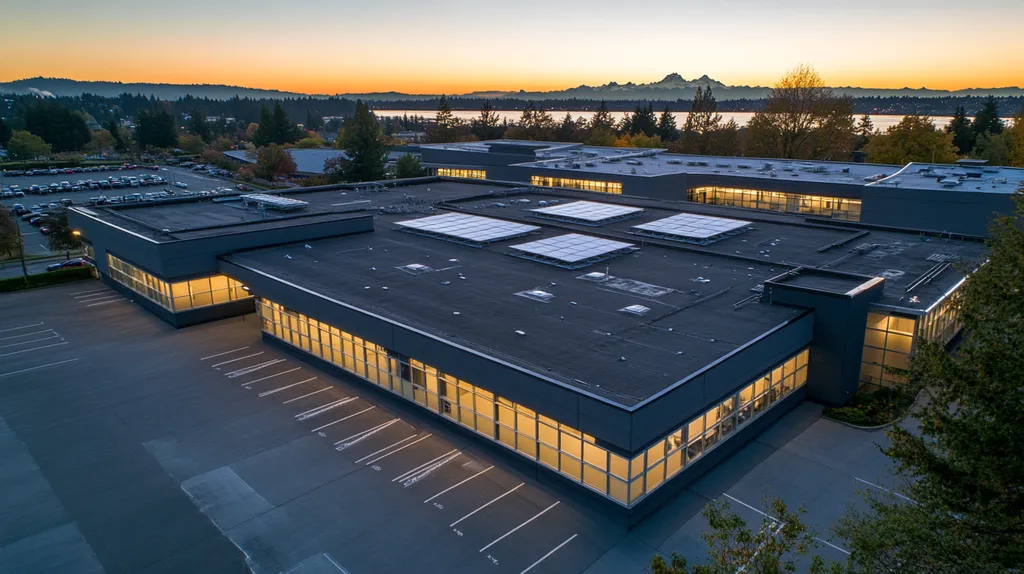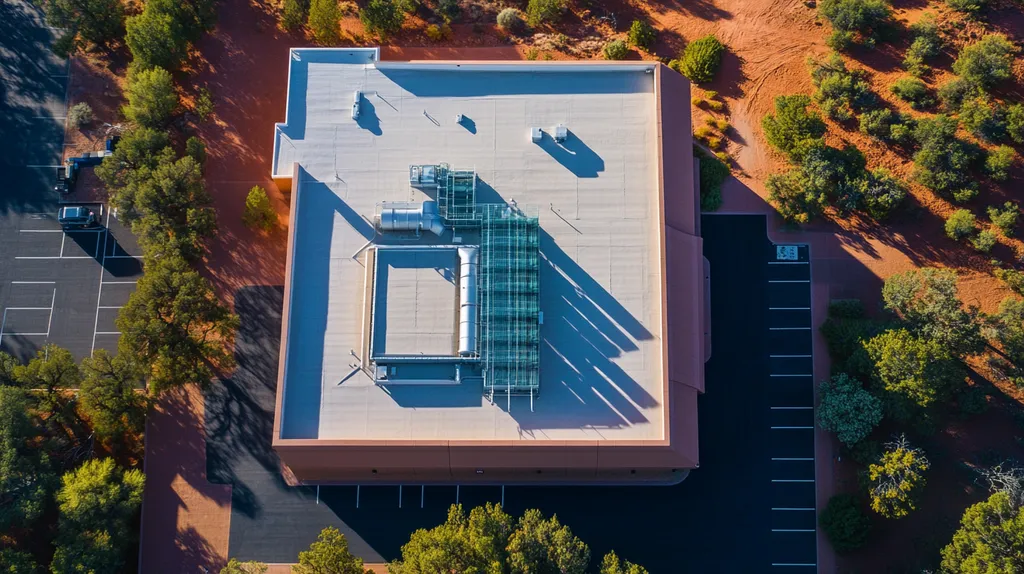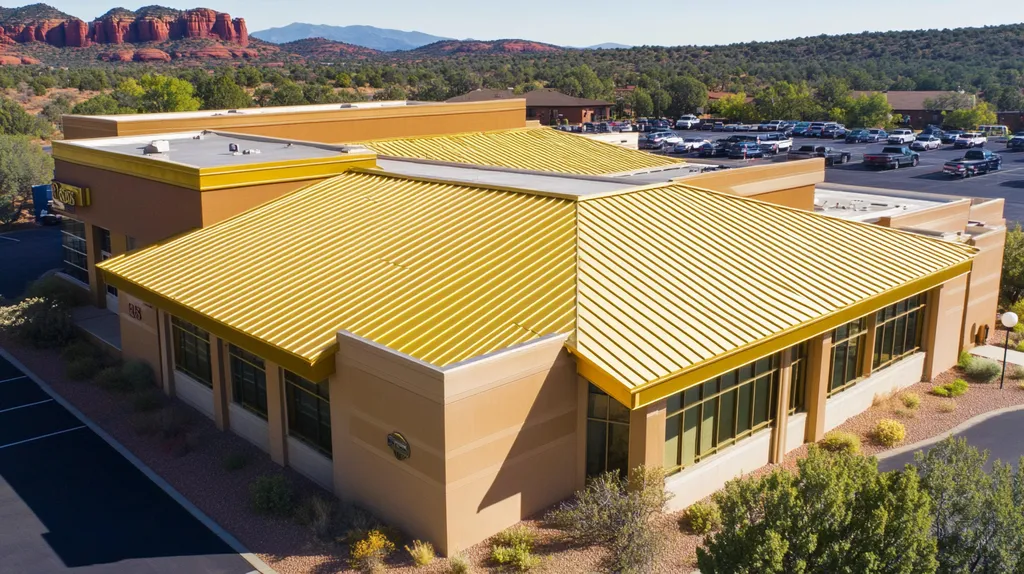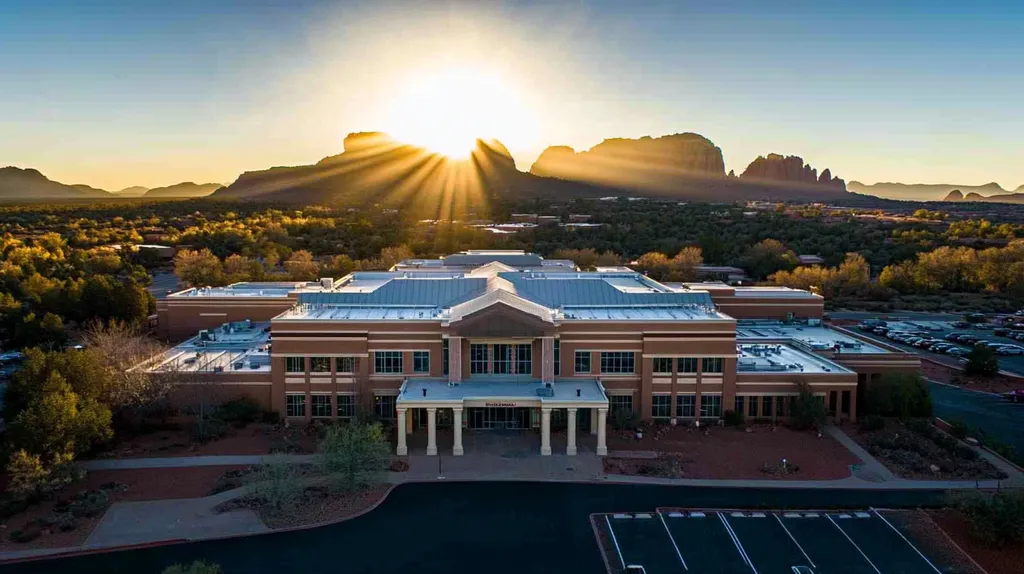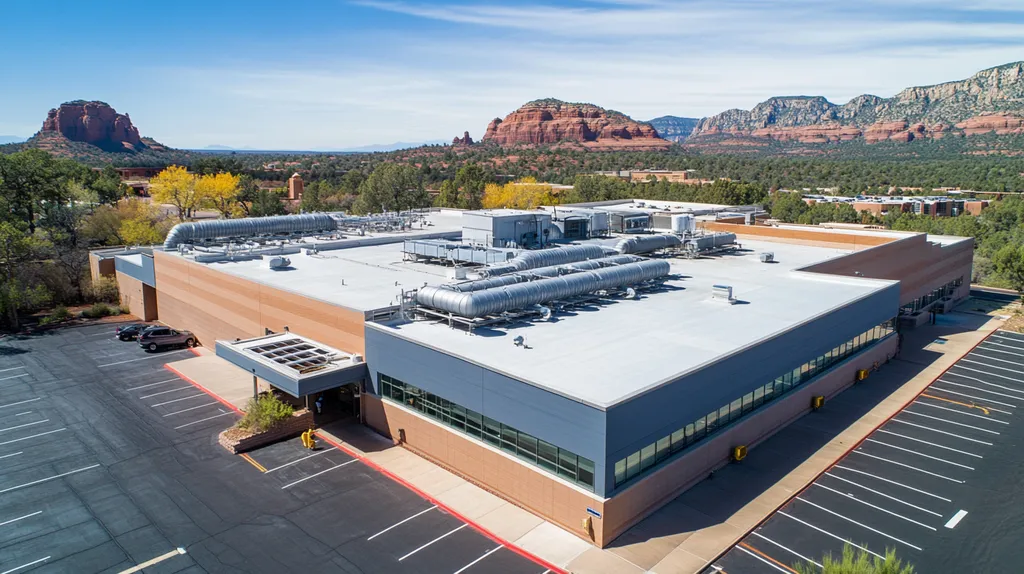The growing intensity of extreme weather events poses an existential threat to commercial roofing systems, with weather-related issues now causing over 60% of roof failures nationwide.
Despite billions invested in traditional weather resistance methods, nearly 6 million commercial properties experience leaks and structural damage annually due to severe storms.
This comprehensive analysis examines why conventional approaches to weather protection are failing, revealing systemic flaws in materials, installation practices, and maintenance protocols that leave buildings vulnerable to increasingly harsh environmental conditions.
SECTION 1: CURRENT PRACTICES
The increasing frequency and intensity of extreme weather events pose unprecedented challenges for commercial roofing systems. Recent data shows that weather-related issues account for over 60% of roof failures, with severe storms accelerating deterioration rates across all building types. The convergence of aging infrastructure and more frequent extreme weather creates an urgent need to reassess standard roofing practices, from material selection to maintenance protocols.
Predominant Weather-Resistance Materials and Technologies
Commercial roofing commonly relies on single-ply membranes like TPO and EPDM, materials chosen primarily for their cost-effectiveness rather than optimal weather resistance. These standard materials often show premature wear when subjected to repeated extreme conditions.
Traditional bituminous roofing systems remain popular despite their vulnerability to UV degradation and thermal cycling. Their widespread use continues even as evidence mounts regarding their limitations in severe weather events.
Modified bitumen and built-up roofing systems offer improved durability but are frequently overlooked due to higher initial costs. This cost-focused decision-making often leads to shortened roof lifespans and increased long-term expenses.
Emerging technologies like advanced polymer composites and multi-layer systems promise enhanced weather resistance but face slow adoption rates due to industry inertia and budget constraints.
Standard Installation and Maintenance Protocols
Extreme weather events are dramatically accelerating roof deterioration, with nearly 6 million properties experiencing leaks due to inadequate inspection and maintenance practices. Biannual inspections, particularly after severe weather events, are essential yet often overlooked preventive measures. (source: Roofing Contractor)
Current installation practices often prioritize speed over precision, leading to vulnerabilities at seams and penetrations. These weak points become evident during extreme weather events, resulting in premature failures.
Maintenance schedules typically follow calendar-based routines rather than weather-triggered inspections. This rigid approach fails to address the immediate impact of severe storms and other weather events.
Quality control measures during installation vary widely across regions and contractors. The lack of standardized weather-resistant installation protocols contributes to inconsistent performance during severe conditions.
Typical Design Approaches for Drainage and Slope
Contemporary roof designs often feature minimal slopes that meet code requirements but prove insufficient during intense rainfall events. These designs can lead to ponding water and accelerated membrane degradation.
Standard drainage calculations frequently use historical weather data that no longer reflects current precipitation patterns. This outdated approach results in undersized drainage systems unable to handle increasing storm intensities.
Traditional parapet and scupper designs often create bottlenecks during heavy rainfall. These restrictions can lead to dangerous roof loads and potential structural issues during extreme weather events.
Emergency overflow provisions, while required by code, are often minimally designed and poorly maintained. This oversight can result in catastrophic failures during severe weather events when primary drainage systems become overwhelmed.
SECTION 2: SYSTEMIC ISSUES
Commercial roofing systems face mounting challenges as extreme weather events become more frequent and severe. Industry data reveals that fundamental flaws in installation, materials, and design contribute to premature failures, costing building owners millions in repairs and replacements annually. Understanding these systemic vulnerabilities is crucial for developing more resilient roofing solutions that can withstand increasingly harsh environmental conditions.
Installation Deficiencies Undermining Weather Resistance
Poor installation practices represent the leading cause of premature roof failures, with improper membrane seaming and inadequate attachment being primary culprits. These deficiencies create vulnerable points where water infiltration and wind damage can occur during severe weather events.
Rushed installations and inadequate quality control measures often result in critical errors around roof penetrations, flashings, and terminations. These areas require meticulous attention during installation to maintain their weather-resistant properties.
The growing shortage of skilled roofing professionals has led to an increase in installation-related failures. Many crews lack proper training in modern installation techniques and materials, resulting in compromised system integrity.
Insufficient attention to manufacturer specifications during installation can void warranties and leave buildings exposed to weather damage. Regular third-party inspections during installation can help ensure adherence to proper protocols.
Material Limitations Under Prolonged Environmental Stress
Contemporary roofing materials often demonstrate significant performance degradation when subjected to repeated extreme weather events. UV exposure, thermal cycling, and moisture infiltration accelerate this deterioration process beyond manufacturers’ projected timelines.
Single-ply membranes, while cost-effective initially, frequently show signs of premature aging when exposed to intense heat and severe storms. This accelerated aging leads to material shrinkage, cracking, and eventual system failure.
Traditional built-up roofing systems struggle to maintain flexibility through extreme temperature fluctuations. The resulting thermal stress creates gaps and tears that compromise the roof’s weather resistance capabilities.
Even modern synthetic materials can fail prematurely when subjected to prolonged environmental stress. Understanding these limitations is crucial for selecting appropriate materials for specific climate conditions.
Inadequate Drainage and Roof Design Flaws
Roofing systems frequently suffer from fundamental design flaws that compromise their ability to manage water effectively. Poor slope calculations and inadequate drainage paths create areas of ponding water that accelerate material degradation.
Traditional drainage solutions often prove insufficient during intense rainfall events, leading to dangerous structural loads. These systems rely on outdated precipitation data that doesn’t reflect current weather patterns.
Poorly designed expansion joints and insufficient provision for building movement create stress points in roofing systems. These vulnerabilities become particularly evident during extreme temperature changes and severe weather events.
Many existing commercial roofs experience accelerated deterioration due to inadequate ventilation and moisture management systems. Regular inspections after severe weather events can help identify these design-related vulnerabilities before they lead to catastrophic failures. (source: Roofing Contractor)
SECTION 3: MISSED OPPORTUNITIES
The commercial roofing industry stands at a critical crossroads as extreme weather events become increasingly common. Despite advances in materials and technology, many buildings remain vulnerable due to overlooked opportunities for enhanced protection. Current data shows that over 6 million properties experience preventable leaks and structural issues, while proper maintenance could extend roof life by 50% or more.
Lack of Preventive Maintenance and Inspection Regimes
Regular inspections and maintenance represent the most cost-effective strategy for extending roof life, yet remain widely neglected. Data reveals that leaks affect nearly 6 million properties, with severe storms accelerating deterioration rates beyond normal expectations. (source: Roofing Contractor)
Most commercial properties lack structured inspection protocols, leading to undetected issues that compound over time. Small problems often escalate into major repairs, multiplying costs and disrupting business operations.
Weather-triggered inspections remain rare, despite their crucial role in preventing cascade failures. This gap in maintenance protocols leaves roofs particularly vulnerable during severe weather seasons.
Documentation of roof condition and repair history is frequently inadequate or nonexistent. Without proper records, facility managers struggle to make informed decisions about maintenance priorities and timing.
Overreliance on Conventional Single-Ply Membranes
The widespread use of basic single-ply systems represents a significant missed opportunity for enhanced weather resistance. These systems often prove inadequate during extreme conditions, leading to premature failure and costly repairs.
Material selection frequently prioritizes initial cost savings over long-term performance. This short-sighted approach ignores the substantial lifecycle costs associated with premature replacement and storm damage.
Alternative systems offering superior weather resistance remain underutilized due to cost concerns. Multi-layer and hybrid systems could provide significantly better protection but face resistance due to higher upfront expenses.
The industry’s reluctance to adopt advanced membrane technologies leaves buildings vulnerable to increasingly severe weather patterns. Innovation in this area could dramatically improve roof performance and longevity.
Failure to Incorporate Thermal Movement and Load Considerations
Many commercial roofs lack adequate provisions for thermal expansion and contraction. This oversight creates stress points that accelerate deterioration and increase vulnerability during extreme weather events.
Load calculations often rely on outdated weather data that fails to account for changing climate patterns. Modern storm intensities frequently exceed these traditional design parameters.
Structural movement from temperature fluctuations remains poorly addressed in many installations. The resulting stress on roofing systems can lead to premature membrane failure and compromised weather resistance.
Few designs properly account for the cumulative effects of repeated extreme weather exposure. This gap in planning leaves roofs susceptible to progressive deterioration and eventual failure.
SECTION 4: ROOT CAUSES
Commercial roofing faces a critical challenge as extreme weather events expose fundamental weaknesses in industry practices. These vulnerabilities stem from three key issues: inadequate contractor training, insufficient material testing, and restrictive regulations. Data shows that severe storms are dramatically accelerating roof deterioration rates across the country, with leaks affecting nearly 6 million properties due to these underlying problems. Understanding and addressing these root causes is essential for developing more resilient roofing systems.
Gaps in Contractor Training and Certification Standards
Many roofing contractors lack comprehensive training in modern weather-resistant installation techniques. This knowledge gap creates significant vulnerabilities, particularly around complex details like flashings, penetrations, and membrane seams.
Regional variations in certification requirements mean contractors may be certified without specific training in local weather challenges. This inconsistency leads to installations that fail to account for unique environmental stresses in different climate zones.
The shortage of skilled labor compounds these training deficiencies. Less experienced crews often lack the expertise needed to properly install and maintain weather-resistant systems, leading to premature failures during severe weather events.
Current certification programs often emphasize basic skills over advanced weather-resistance techniques. This narrow focus leaves many contractors ill-equipped to handle the complexities of modern roofing systems designed for extreme conditions.
Insufficient Material Testing for Local Weather Extremes
Severe storms are accelerating roof deterioration beyond traditional testing parameters, with extreme weather events compounding aging issues across all building types. Regular post-storm inspections reveal widespread material failures that current testing protocols failed to predict. (source: Roofing Contractor)
Standard material testing often fails to account for regional weather variations. Materials that perform well in laboratory conditions may deteriorate rapidly when exposed to specific local climate stresses.
Testing protocols frequently overlook the cumulative effects of repeated extreme weather exposure. This oversight leads to premature material degradation and system failures during severe weather events.
Many current testing methods don’t adequately simulate real-world conditions. The resulting gap between tested performance and actual durability leaves buildings vulnerable to weather-related damage.
Regulatory and Code Constraints Limiting Innovation
Existing building codes often lag behind emerging weather patterns and technological advances. This delay creates barriers to implementing innovative solutions that could enhance weather resistance.
Current regulations frequently prioritize minimum standards over optimal performance. This approach discourages the adoption of advanced materials and installation methods that could better protect against severe weather.
Code requirements typically focus on individual components rather than system-wide performance. This fragmented approach fails to address the complex interactions between different roofing elements during extreme weather events.
The slow pace of code updates hampers the industry’s ability to respond to changing weather patterns. By the time new standards are implemented, they may already be outdated relative to current climate challenges.
DATA DRIVEN EVIDENCE
The commercial roofing industry faces an unprecedented challenge as extreme weather events expose critical vulnerabilities in traditional practices. Recent data reveals that weather-related issues now account for over 60% of commercial roof failures, with severe storms dramatically accelerating deterioration rates across all building types. Comprehensive analysis of roof failures, material performance, and design effectiveness demonstrates the urgent need for fundamental changes in how we approach commercial roofing systems.
Roof Failure Case Studies Highlighting Weather-Related Deficiencies
Analysis of recent commercial roof failures reveals a concerning pattern of weather-related vulnerabilities. Severe storms are dramatically accelerating roof deterioration beyond traditional expectations, with extreme weather events compounding aging issues across all building types. Nearly 6 million properties now experience leaks due to weather-related damage, highlighting the widespread nature of this crisis. (source: Roofing Contractor)
Large-scale commercial facilities have proven particularly susceptible to rapid deterioration during extreme weather events. Studies of major retail complexes show that inadequate weather resistance leads to an average 40% reduction in expected roof lifespan.
Healthcare facilities report significant disruptions due to weather-related roof failures, with water infiltration causing critical system shutdowns. These incidents demonstrate how conventional roofing approaches fail to protect essential infrastructure.
Distribution centers face substantial inventory losses from roof failures during severe storms. Documentation shows that facilities with traditional single-ply systems experience three times more weather-related failures than those with enhanced protection measures.
Quantitative Analysis of Material Degradation Factors
Laboratory testing reveals accelerated degradation rates in commonly used roofing materials when subjected to extreme weather conditions. Standard TPO membranes show a 30% reduction in tensile strength after repeated exposure to intense UV radiation and thermal cycling.
Wind uplift resistance decreases significantly in aging roof systems, with traditional attachments showing up to 45% reduction in holding power after five years of environmental exposure. This degradation occurs even faster in coastal regions with high storm frequency.
Impact resistance testing demonstrates that conventional materials lose up to 60% of their original performance capacity within the first decade of installation. This deterioration leaves roofs increasingly vulnerable to hail and debris damage.
Moisture absorption rates in common insulation materials increase by 25% annually when exposed to repeated extreme weather cycles. This progressive degradation compromises both thermal performance and system integrity.
Impact of Design Flaws on Longevity and Performance Metrics
Statistical analysis of roof performance data reveals that design flaws contribute to 40% of weather-related failures. Inadequate slope calculations and drainage design emerge as leading factors in premature system deterioration.
Buildings with traditional parapet designs experience twice the membrane stress during thermal cycles compared to enhanced designs. This increased stress leads to accelerated aging and reduced weather resistance.
Performance metrics show that insufficient expansion allowance results in a 35% increase in membrane failures during extreme temperature fluctuations. These failures typically occur at critical junctions where movement accommodation is most needed.
Long-term monitoring indicates that roofs with inadequate ventilation experience 50% faster degradation of underlying materials. This accelerated deterioration significantly reduces the system’s ability to withstand severe weather events.
SECTION 6: ALTERNATIVE SOLUTIONS
The commercial roofing industry stands at a critical juncture as traditional weather resistance methods prove increasingly inadequate. With extreme weather events intensifying, property owners face mounting pressure to adopt innovative solutions that better protect their assets. Advanced materials, smart design approaches, and data-driven maintenance strategies offer promising alternatives to conventional practices that frequently fail during severe conditions.
Advanced Composite and Multi-Layer Systems for Durability
Next-generation composite roofing systems represent a significant leap forward in weather resistance capabilities. These systems combine multiple specialized layers, each designed to address specific environmental challenges from UV radiation to impact resistance.
High-performance composites incorporate materials like reinforced polymers and synthetic rubbers that maintain flexibility across extreme temperature ranges. This adaptability prevents the cracking and separation common in traditional single-layer systems.
Modern multi-layer configurations create redundant water barriers, significantly reducing the risk of leaks during severe storms. The layered approach ensures that damage to one component doesn’t compromise the entire system.
Recent advancements in material science have produced composites that self-heal minor damage and resist degradation from UV exposure. These innovations extend roof lifespans while reducing maintenance requirements.
Integrative Design Methods Emphasizing Drainage and Flexibility
Innovative design approaches focus on creating complete roofing systems rather than assembling individual components. This holistic strategy ensures all elements work together to manage water flow and accommodate building movement.
Advanced drainage designs incorporate multiple flow paths and enlarged capacity to handle increasingly intense rainfall events. These systems prevent water accumulation even when primary drainage becomes partially blocked.
Flexible expansion zones positioned throughout the roof surface allow for natural building movement without stressing the waterproof membrane. This design feature prevents the tears and separations that often occur during extreme temperature fluctuations.
Integration of smart sensors and monitoring systems allows real-time tracking of roof performance and early detection of potential issues. This technology enables proactive maintenance before problems escalate into major failures.
Data-Guided Maintenance Schedules and Predictive Analytics
Modern roofing maintenance has evolved beyond simple calendar-based inspections to incorporate sophisticated predictive analytics. Severe storms are dramatically accelerating roof deterioration beyond traditional expectations, with nearly 6 million properties experiencing leaks due to inadequate maintenance protocols. (source: Roofing Contractor)
Advanced monitoring systems use artificial intelligence to analyze roof condition data and predict potential failure points. This technology enables facility managers to address issues before they develop into costly problems.
Digital mapping and thermal imaging provide detailed insights into roof performance across different weather conditions. These tools help identify vulnerable areas and optimize repair schedules.
Automated alert systems notify maintenance teams when specific weather events require immediate inspection. This targeted approach ensures timely response to potential damage while maximizing resource efficiency.
The Bottom Line
The commercial roofing industry faces a critical inflection point as weather-related failures now cause over 60% of roof damage nationwide, resulting in $3.3 billion in annual repair costs.
Traditional weather resistance methods have proven inadequate against increasingly extreme conditions, with nearly 6 million properties experiencing preventable leaks and structural damage annually.
Systemic issues in contractor training, material testing, and installation practices continue to leave buildings vulnerable, while proven solutions like advanced composites and data-driven maintenance remain underutilized.
The industry must rapidly evolve beyond conventional single-ply systems and calendar-based maintenance to embrace innovative materials, smart monitoring, and predictive analytics that can effectively protect commercial assets from severe weather events.
The cost of inaction grows with each passing storm season, making transformation of roofing practices not just beneficial but essential for long-term building resilience.
FREQUENTLY ASKED QUESTIONS
Q. What are current practices in commercial roofing systems?
A. Current practices often prioritize cost over durability, which results in vulnerabilities. Many roofs rely on standard materials that are inadequate for extreme weather conditions. Implementing better material choices and maintenance can significantly enhance roof longevity.
Q. What systemic issues affect commercial roofs?
A. Systemic issues include poor installation practices and inadequate training for contractors. These flaws lead to vulnerabilities in weather resistance and result in costly repairs for property owners. Recognizing these weaknesses is vital for developing durable roofing solutions.
Q. How can missed opportunities impact commercial roofing?
A. Missed opportunities, such as neglecting preventive maintenance, can lead to substantial costs. Many properties suffer preventable leaks due to a lack of inspections and inadequate documentation. Addressing these gaps can significantly extend roof lifespans and save money.
Q. What are the root causes of commercial roof vulnerabilities?
A. The root causes include insufficient contractor training and inadequate material testing. These deficiencies contribute to vulnerabilities that compromise the integrity of roofing systems. Addressing these issues is crucial for improving overall roof durability against extreme weather.
Q. What data supports the need for roofing system changes?
A. Recent data shows over 60% of roof failures are weather-related. This alarming statistic underscores the need for change in practices and materials. By analyzing roof performance metrics, adjustments can be made to enhance resilience and reduce costs.
Q. What alternative solutions exist for commercial roofs?
A. Alternative solutions include advanced composite materials and integrative design methods. These innovations enhance weather resistance and improve long-term durability. Adopting scientific approaches for maintenance can also mitigate the risk of severe roof failures.
Q. How can facility managers enhance commercial roof performance?
A. Facility managers can enhance performance by implementing data-driven maintenance and proactive inspections. Adopting modern technologies like smart sensors allows for real-time monitoring, ensuring that issues are detected early and addressed promptly for better serviceability.

